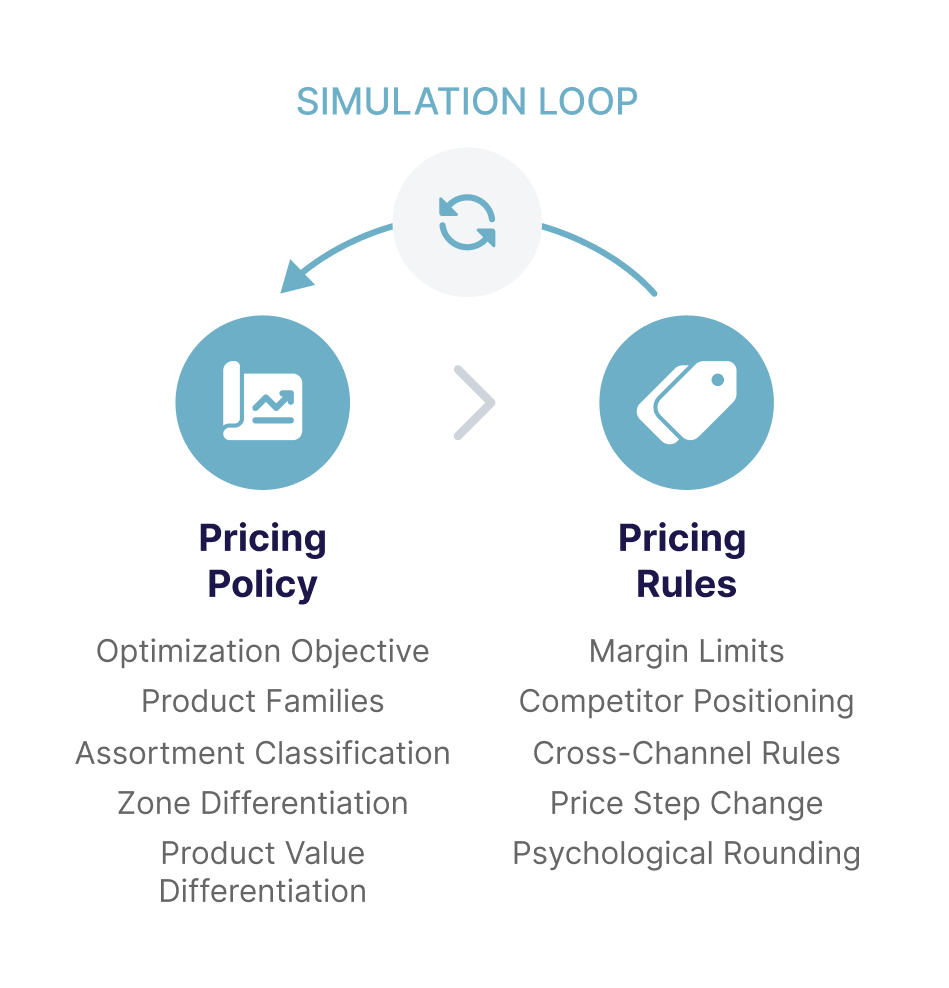You Can Test the Effectiveness of Your Pricing Strategy Before Executing It? YES!
If what-if simulations are still an unknown technology to your retail organization’s pricing team, you are in fact at risk of being surpassed by the competition.
Otherwise known as what-if scenarios, this ML/AI feature found within top-tier price management solutions can absolutely be the difference between a successful pricing strategy and an unsuccessful one. Similar in technological essence to price elasticities, what-if simulations are also based on firm mathematical constructs and well-implemented, clean data, all fully under end-user control. When using what-if scenarios, pricing teams are empowered to render accurate and truly actionable pricing figures, with ease.
It’s unfortunately true that we encounter many organizations who have not yet evolved from antiquated pricing tools (if any, beyond Excel), and as such what-if simulations are unknown to them. Pricing managers in these organizations typically incur high levels of scrutiny from their leadership and face endless manhours, manual tasks, and heavily loaded Excel files that truly make their job extremely difficult. Worst of all, they cannot obtain the results they need to keep driving a thriving retail business, putting company margins and their jobs at risk.
This article aims to help pricing professionals of all technical backgrounds understand what this extremely powerful ML/AI technology does. We will break down the inner workings of what-if simulations for the more experienced pricing experts who want to know what is really behind the brilliant results they deliver. And of course, we will start with the basics for newbie or aspiring what-if pricing heroes.
Disclaimer: Due to the advanced level of what-if technology offered by Yieldigo — something that most of our competitors can only aspire to have — we are not able to give precise details into how we built our ML/AI simulation engine with specific and exact build attributes (it’s a secret recipe). In this article, we will learn about the math and science behind what-if, and some insights into how we apply this pricing technique in Yieldigo software.
Let’s dive into the business value, common usage, and science of what-if simulations within retail price management software!
What-If Simulation Basics
Before we do a tech dive into what-if scenarios, let’s explore the different ways in which the grand majority of retailers put this feature to use. The business value and common usage cases we will see here help to illustrate the reasoning behind its technological build, which we will look at more closely in the latter part of this article.
Business Value
By definition, what-if analysis is a data-based simulation (based on your data) with the primary objective to evaluate behavior and results of a complex environment under some probable scenarios. What-if simulations analyze the impact of changes made within a set of independent variables performed on a set of dependent variables. Within a retail price management software in real-world terms, it lets you see how the pricing strategy you would like to set forth will likely perform across business objectives before you actually launch it.
If the prospect of the projected effects of a given strategy is desirable, pricing teams can then choose to proceed, and even make updates to it, so that it’s well-suited to their end-goals. However, if the effects of the strategy will be deemed as unadvisable by pricing managers or leadership, they can simulate entirely new strategies until they achieve the results they seek to obtain. It can serve the critical purpose of being a testbed of strategies that either render desired results, or that serve as a guide to not proceed with a particular course of action.
The ability to choose well-tested, optimal-performing pricing strategies that deliver the most precise and beneficial results possible is clearly a game-changer for pricing teams. This level of control within a retail organization’s pricing strategy saves margins, renders improved promotion results, and helps pricing managers and category managers better defend their position when taking a new course of action with their prices. But, beyond it being some kind of fancy “alibi”, it in fact streamlines the daunting task of pricing, all while practically ensuring desired business results.
Let’s evaluate some common use cases to further illustrate what pricing experts can achieve with them.
The 6 Most Common What-If Simulation Use Cases Specific to Retail Price Management
What-if simulations can serve various purposes for a retail business. Typical end-users like Pricing Managers, Category Managers, Buying teams, and Marketing teams can use what-if simulations to model different business scenarios. These pricing professionals and their teams use what-if scenarios to assess the potential impact of many different strategy types before making decisions. What-if simulations help mitigate risks, optimize operations, and maximize profitability.
Here are 6 common ways retailers use what-if scenarios and the business value that each provides:
1. Competitive Price Positioning
Competitive Price Positioning is knowing how your prices compare to your competitors’. Pricing Managers often face the question, “What if we undercut our competitor’s prices by X%?. How much margin will we use and what quantity of sales can we gain?” Imagine being able to answer this question by performing tests on multiple assortment categories and product groups. Having quick and accurate answers in such situations is a business-critical capability.
2. Pricing Optimization
As we noted above, retail pricing teams can simulate price changes for different products or categories and assess the impact on sales volume, revenue, and profitability. This process is driven by creating a set of pricing rules, possibly combined with an optimization objective — it helps retailers determine optimal pricing to maximize revenue or profit margin while staying competitive.
3. Demand Forecasting & Inventory Management
Demand forecasting and inventory management is an analysis of what quantity of a particular SKU or group of SKUs is needed in order to satisfy consumer demand, and avoid waste. Using what-if simulations to test various demand scenarios (e.g., seasonal spikes, promotional effects, reaction to different price points) helps to ensure adequate inventory levels. You can reduce stockouts and overstocking, improve customer satisfaction, and minimize holding costs.
4. Promotional Campaign Impact
As we saw in our previous promotion planning article, planning effective promotional campaigns also benefits greatly from ML/AI features — a very similar, if not, exact technological mechanism to what-if scenarios. Modeling the impact of discounts, special offers, and loyalty programs based on customer behavior and profitability helps refine promotional strategies to ensure maximum ROI and margin retention. You can read more about how to run effective and accurate promotions in this article.
5. Economic & Market Impact Scenarios
Using what-if simulations to assess the impact of inflation on increased costs of goods from your suppliers on consumer spending and profitability is a great business insurance process. Doing so prepares businesses for macroeconomic shifts and enables proactive decision-making across the company management. Feel free to read more about how price management software can help retail businesses navigate uncertain financial conditions.
6. Omnichannel Strategy Optimization
Simulating different digital and physical store pricing strategies is a great way to put what-if scenarios to use. This technique helps to enhance customer perception, as the customer behavior tends to be different across the sales channels, leading to an overall increase in sales.
Internal Workings: The What-If Simulation ML/AI Engine in Yieldigo
Yieldigo software’s what-if simulations take place across the pricing policy stage and the price ranges stage, as seen in the diagram. When testing a potential strategy using what-if, a simulation loop takes place between the pricing policy and price ranges stages. This means that when actually testing a potential pricing strategy, it is within this portion of the overall pricing process where what-if simulations take place. The entire process is based on your up-to-date data inputs, leveraging all the learnings of analytical models used in the standard pricing process.
Yieldigo Simulation Loop: Pricing Policy and Price Ranges
In the diagram, we can see the entire pricing process within Yieldigo price management software. To best understand how what-if scenarios work in the software, let’s do a basic-level analysis to evaluate the overall process that is occurring in the simulations loop.
If we break down pricing policy and price ranges into their individual parts, there are 10 different testable categories and factors involved.
There are five pricing policy types:
- Optimization Objective
- Product Families
- Assortment Classification
- Zone Differentiation
- Product Value Differentiation
And, there are five pricing rule categories:
- Margin Limits
- Competitor Positioning
- Cross-Channel Rules
- Price Step Change
- Psychological Rounding

These five pricing policy types and rule categories can all potentially be tested between each other within a what-if simulation instance, or multiple. Now, there can be a very large number of each one of these different pricing policies and price range rules — some may have thousands of different options available — depending on your retail businesses specific needs, different exceptions set on product categories, brands, even individual SKUs, possible combinations of these, and various instances you can test for each. This means that the number of scenarios to test and different outcomes and combinations that can be achieved in total are nearly infinite.
This intricacy is not an unnecessary complexity, especially when considering that it is up to the end user to decide up to what degree they want to control a particular pricing strategy outcome. But, most of all, an excellent pricing manager or pricing team can use this technology to gain an extremely powerful competitive edge over other retailers in their industry and location. Learning to cleverly wield this highly strategic pricing technique is a necessary skill for pricing managers of competitive retail organizations who seek to thrive in today’s very saturated retail market, regardless of the industry in question.
And what happens after the end-user selects their winning strategy (or strategies) in Yieldigo? If we look at the diagram above again, we can see that it becomes part of the continuous feedback loop. Therefore, the chosen strategy is applied to every part of the pricing process through to your business’s daily transactions and purchases, recorded and stored to continuously improve the pricing process based on your data and the goals you’ve established.
Now that we’ve identified the logic behind what-if simulations and what’s being tested, let’s look into five common potential decisions and outcomes pricing managers can test to make the most out of this technology.
Potential Decisions Managers Can Test with What-If Simulations in Yieldigo
As we’ve seen in this article thus far, what-if scenarios are built to test pricing strategies and many other potential business results in between.
5 Real-World Examples of Decisions Pricing Managers Can Test
- Setting objectives to increase revenue, margin, volume, etc. – “Optimization” is absolutely an overused term — however, in literal pricing terminology, that’s exactly what’s occurring. Setting goals to improve revenue, margin, volume or anything in between is a common approach. Embarking on these missions armed with reliable strategies that have been tested not only brings peace of mind, but also is the maximum you can do to ensure the best results possible.
- Exacting change to a set of rules for a specific product category or assortment class, such as KVIs – Adjusting any pricing rules can be a double-edged sword — getting it right can do wonders for retail businesses, but getting it wrong can be very counter-productive. This is precisely why testing what potential results the rules changes will render is so critical. A poor change in rules on these larger product groupings can leave a hefty dent on overall margins. Thus, what-if simulations can absolutely spare large losses, and even drive revenues up much further with clever, well-informed rules updates.
- Setting a specific strategy per store format, region, or pricing zone – A large-scale strategic consideration should never go untested. Luckily, what-if simulations can absolutely be used to test virtually any given strategy in various different store formats, regions, and pricing zones.
- Introducing or adjusting hard rules such as minimum margin on products – Even adjusting rules on specific products can be tricky, applying those globally can lead to unexpected results. Using what-if simulations to test hard rules is absolutely critical as it can set either a great benchmark for the rest of your pricing decisions, or lead you to reconsider the particular pricing guidelines you intend to set.
- Trying different positioning against your market competitors – Retail business is extremely competitor-centric. As such, what-if simulations are critical in helping identify which different pricing strategies and tactics will work best against your competitors. You can read more about how price management helps ward off even the toughest of competitors in this article.
All of the above may be applied to any group of products, category, brand and so forth, all while being able to see the specific impacts for each.
It should be evident that what-if simulations give retail pricing managers and their organizations some very clear and big advantages. It’s easy to see why they have become such a necessary feature for retail professionals in all industries.
Conclusion: “What-If…”
“What-if we want to raise overall margin by 1%? Top management is asking me to generate as much profit as possible in order to maintain large-scale growth. How can I impact my competitor’s price index and customer purchasing behavior?” Test it with what-if simulations and see, as well as any smaller or larger considerations! The beauty of what-if scenarios, as we covered in this article, is that pricing managers can make better-informed pricing strategies and decisions. Well-integrated data input into an advanced ML/AI pricing software, navigated at the helm of savvy pricing professionals is the core of a game-changing retail pricing armada that can keep competition at bay, and reap winning results.
If you would like to learn more about what-if simulations in Yieldigo price management software, you can schedule a call with our expert.


